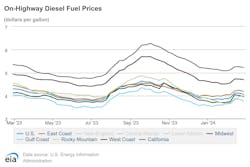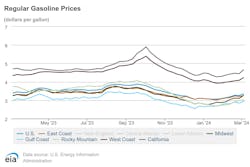Spring break raises gas prices, diesel costs down
Fuel costs between gasoline and diesel diverged in a marked way over the past week. As of March 4, the U.S. Energy Information Administration (EIA) reported that diesel prices fell in most regions across the country, with the national average reaching $4.022 per gallon. Meanwhile, gas prices saw the exact opposite, with the national average rising 10 cents to reach $3.350 per gallon.
For diesel costs, the national average decreased 3 cents from last week and were 26 cents cheaper than last year, a trend which almost every other region mirrored. The only areas that saw diesel prices rise were California, where prices increased less than a cent to $5.228 per gallon, and the Rocky Mountain Region, which also increased less than a cent to $4.077.
In comparison, ever other region saw relatively small price decreases, the largest being 7 cents in the West Coast without California. Including California in average fuel price calculations, the Lower Atlantic subregion saw diesel prices drop by 4 cents to $4.077, with the Midwest area decreasing a similar amount to $3.919 per gallon. The regions whose diesel price decreases were the smallest include the New England and Central Atlantic subregions, both of which dropped by less than a cent.
With these factors in mind, the Gulf Coast is still the cheapest place to purchase diesel fuel at $3.731 per gallon, while California is still the most expensive at $3.731.
Read more: Gas and diesel prices down as Indiana refinery set to reopen
In comparison, the AAA motor club logged an average diesel price fuel price of $4.05 per gallon, more expensive than the EIA by 3 cents, and more expensive than last week’s average of $4.071 by 2 cents. It is still cheaper than last year’s diesel price average of $4.387.
Gasoline prices surge to $3.50 per gallon
While diesel prices decreased marginally, gasoline prices rose across the board at a much higher rate. The current nationwide average for U.S. regular gasoline prices is 10 cents higher than last week at $3.50, and only 3 cents less than this time last year.
Prices also surged across the country, with some areas, such as the Lower Atlantic subregion and the Midwest, higher than both last week’s average and this same period last year. For the Lower Atlantic, prices are at $3.190 per gallon, 4 cents higher than last week and 5 cents more than last year. For the Midwest, the EIA logged gas prices at $3.269 per gallon, 17 cents higher than last week and less than a cent higher than last year.
Otherwise, gas price increases varied widely across the country, from less than a cent all the way up to 21 cents in California. The lowest price increases were in the New England and Central Atlantic subregions, which rose less than a cent and 2 cents, respectively.
The Gulf Coast is still the cheapest place for gasoline fuel at $2.949, and California is the most expensive at $4.651 per gallon.
The AAA also noted this price increase, with their average measuring up at $3.352 per gallon, 9 cents more than the week before, and only 4 cents better than this time last year. The reason for this increase could be due to an increase in travelers for Spring Break, the organization hypothesized.
“We’re entering Spring Break season, and historically, March and April bring higher gas prices as demand rises,” said Aixa Diaz, AAA spokesperson. “With milder temperatures come more road trips, and this time of year tends to be a precursor to the summer driving season.”
This article was originally published on FleetOwner.com.
About the Author

Alex Keenan
Alex Keenan is an Associate Editor for Fleet Maintenance magazine. She has written on a variety of topics for the past several years and recently joined the transportation industry, reviewing content covering technician challenges and breaking industry news. She holds a bachelor's degree in English from Colorado State University in Fort Collins, Colorado.


